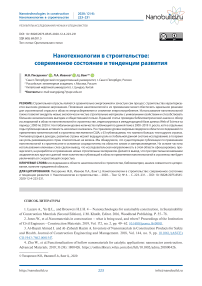Nanotechnology in construction: state of the art and future trends
Автор: Pisarenko Pisarenko, Ivanov L.A., Wang Q.
Журнал: Нанотехнологии в строительстве: научный интернет-журнал @nanobuild
Рубрика: Результаты исследований ученых и специалистов
Статья в выпуске: 4 т.12, 2020 года.
Бесплатный доступ
The construction industry has long been regarded asenergy-intensive and high pollution industry. The emergence of nanotechnology provides an ideal solution for the construction industry to energy saving and consumption reduction. The introduction of nanotechnology has greatly promoted the development of new green building materials and brought huge economic and social benefits. This paper applies bibliometric analysis to review the nanotechnology-construction research collected by Web of Science database during 2000-2020, and further visualize their literature characteristics. At the global level, the number of literatures on nanotechnology-construction research has been on the rise in 2000-2019, although it has experienced a small decline in individual years. At the national level, the United States has become the global leader in nanotechnology-construction research with 63 articles, far more than other countries. Considering the income gap, developed countries play an indispensable role in the global nanotechnology-construction research system, while the role of developing countries is relatively weak. We found that the existing nanotechnology-construction research mainly focused on the fields of chemistry and materials science. According to the frequency of keywords, the research focus of nanotechnology-construction research mainly focused on the development and application of new building materials. It is concluded that with the extensive attention of researchers, the future research on nanotechnology-construction will continue to appear and increase at increasing rate.
Nanotechnology-construction research, bibliometrics, co-citation analysis, mapping knowledge domains
Короткий адрес: https://sciup.org/142225525
IDR: 142225525 | УДК: 69.001.5 | DOI: 10.15828/2075-8545-2020-12-4-223-231
Текст научной статьи Nanotechnology in construction: state of the art and future trends
Список литературы Nanotechnology in construction: state of the art and future trends
- Lazaro A., Yu Q.L., and Brouwers H.J.H. 4 - Nanotechnologies for sustainable construction, in Sustainability of Construction Materials (Second Edition), J.M. Khatib, Editor. 2016, Woodhead Publishing. Р. 55-78.
- Jones W., et al.Nanomaterials in construction - what is being used, and where? Proceedings of the Institution of Civil Engineers - Construction Materials. 2019, Vol. 172, no. 2, pp. 49-62. DOI: 10.1680/icoma.16.00011
- Al-Bayati Ahmed J. and Al-Zubaidi Hazim A. Inventory of Nanomaterials in Construction Products for Safety and Health. Journal of Construction Engineering and Management. 2018, Vol. 144, no. 9, pp. 10.1061/(ASCE) CO.1943-7862.0001547. DOI: 10.1061/(ASCE)CO.1943-7862.0001547
- Zhu W., et al.Functionalization of hollow nanomaterials for catalytic applications: nanoreactor construction. Advanced Materials. 2019; 31(38): 1800426. https://onlinelibrary.wiley.com/doi/full/. DOI: 10.1002/adma.201800426
- Contreras, J.E., E.A. Rodriguez, and J. Taha-Tijerina. Nanotechnology applications for electrical transformers -A review. Electric Power Systems Research. 2017, Vol. 143, pp. 573-584. DOI: 10.1016/j.epsr.2016.10.058
- West, G.H., et al.Toward responsible development and effective risk management of nano-enabled products in the U.S. construction industry. Journal of Nanoparticle Research. 2016, Vol. 18, no. 2, pp. 49. -y.
- DOI: 10.1007/s11051-016-3352
- Mongeon, P. and A. Paul-Hus.The journal coverage of Web of Science and Scopus: a comparative analysis. Scientometrics. 2016, Vol. 106, no. 1, pp. 213-228.
- DOI: 10.1007/s11192-015-1765-5
- Yang, D., et al.History and trends in solar irradiance and PV power forecasting: A preliminary assessment and review using text mining. Solar Energy. 2018, Vol. 168, pp. 60-101.
- DOI: 10.1016/j.solener.2017.11.023
- Wang, J., R. Veugelers, and P. Stephan.Bias against novelty in science: A cautionary tale for users of bibliometric indicators. Research Policy. 2017, Vol. 46, no. 8, pp. 1416-1436.
- DOI: 10.1016/j.respol.2017.06.006
- Laengle, S., et al.Forty years of the European Journal of Operational Research: A bibliometric overview. European Journal of Operational Research. 2017, Vol. 262, no. 3, pp. 803-816.
- DOI: 10.1016/j.ejor.2017.04.027
- Geng, S., et al.Building life cycle assessment research: A review by bibliometric analysis. Renewable and Sustainable Energy Reviews. 2017, Vol. 76, pp. 176-184.
- DOI: 10.1016/j.rser.2017.03.068
- Zheng, L., T. Xiong, and K.W. Shah.Transparent nanomaterial-based solar cool coatings: Synthesis, morphologies and applications. Solar Energy. 2019, Vol. 193, pp. 837-858.
- DOI: 10.1016/j.solener.2019.10.029
- Dahlan, A.S.Smart and Functional Materials Based Nanomaterials in Construction Styles in Nano-Architecture. Silicon. 2019, Vol. 11, no. 4, pp. 1949-1953. -x.
- DOI: 10.1007/s12633-018-0015
- Wu, Z., et al.Effects of different nanomaterials on hardening and performance of ultra-high strength concrete (UHSC). Cement and Concrete Composites. 2016, Vol. 70, pp. 24-34.
- DOI: 10.1016/j.cemcon-comp.2016.03.003
- Diab, A.M., et al.Effect of nanomaterials additives on performance of concrete resistance against magnesium sulfate and acids. Construction and Building Materials. 2019, Vol. 210, pp. 210-231.
- DOI: 10.1016/j.con-buildmat.2019.03.099
- Bossa, N., et al.Environmental exposure to TiO2 nanomaterials incorporated in building material. Environmental Pollution. 2017, Vol. 220, pp. 1160-1170.
- DOI: 10.1016/j.envpol.2016.11.019
- Sierra-Fernandez, A., et al.New nanomaterials for applications in conservation and restoration of stony materials: A review. Materialesde Construccion. 2017, Vol. 67, no. 325, pp. 107.
- Иванов Л.А., Разумеев К.Э., Бокова Е.С., Муминова С.Р. Изобретения в области нанотехнологий, направленные на решение практических задач. Часть V // Нанотехнологии в строительстве. - 2019. - Том 11, № 6. - С. 719-729. -
- DOI: 10.15828/2075-8545-2019-11-6-719-729
- Иванов Л.А., Бокова Е.С., Муминова С.Р., Катухин Л.Ф. Изобретения, основанные на использовании нанотехнологий, позволяют получить принципиально новые технические результаты. Часть I // Нанотехнологии в строительстве. - 2020. - Том 12, № 1. - С. 27-33. -
- DOI: 10.15828/2075-8545-2020-12-1-27-33
- Иванов Л.А., Капустин И.А., Борисова О.Н., Писаренко Ж.В. Изобретения, основанные на использовании нанотехнологий, позволяют получить принципиально новые технические результаты. Часть II // Нанотехнологии в строительстве. - 2020. - Том 12, № 2. - С. 71-76. - DOI: 10.1.5828/207.5-8.545-2020-12-2-71-76.
- Иванов Л.А., Деменев А.В., Писаренко Ж.В., Ванг Ц. Изобретения, основанные на использовании нанотехнологий, позволяют получить принципиально новые технические результаты. Часть III // Нанотехнологии в строительстве. - 2020. - Том 12, № 3. - С. 140-146. -
- DOI: 10.15828/207.5-8.545-2020-12-.3-140-146


